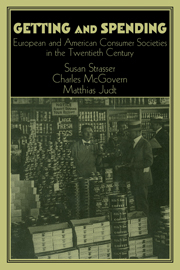Book contents
- Frontmatter
- Introduction
- Part One Politics, Markets, and the State
- 1 The Consumers' White Label Campaign of the National Consumers' League, 1898-1918
- 2 Consumption and Citizenship in the United States, 1900-1940
- 3 Changing Consumption Regimes in Europe, 1930-1970: Comparative Perspectives on the Distribution Problem
- 4 Customer Research as Public Relations: General Motors in the 1930s
- 5 The New Deal State and the Making of Citizen Consumers
- 6 Consumer Spending as State Project: Yesterday's Solutions and Today's Problems
- 7 The Emigré as Celebrant of American Consumer Culture: George Katona and Ernest Dichter
- 8 Dissolution of the “Dictatorship over Needs”?: Consumer Behavior and Economic Reform in East Germany in the 1960s
- Part Two Everyday Life
- Part Three History and Theory
- Index
1 - The Consumers' White Label Campaign of the National Consumers' League, 1898-1918
Published online by Cambridge University Press: 05 January 2013
- Frontmatter
- Introduction
- Part One Politics, Markets, and the State
- 1 The Consumers' White Label Campaign of the National Consumers' League, 1898-1918
- 2 Consumption and Citizenship in the United States, 1900-1940
- 3 Changing Consumption Regimes in Europe, 1930-1970: Comparative Perspectives on the Distribution Problem
- 4 Customer Research as Public Relations: General Motors in the 1930s
- 5 The New Deal State and the Making of Citizen Consumers
- 6 Consumer Spending as State Project: Yesterday's Solutions and Today's Problems
- 7 The Emigré as Celebrant of American Consumer Culture: George Katona and Ernest Dichter
- 8 Dissolution of the “Dictatorship over Needs”?: Consumer Behavior and Economic Reform in East Germany in the 1960s
- Part Two Everyday Life
- Part Three History and Theory
- Index
Summary
In a series of articles that exposed virulent sweatshops in New York City and Los Angeles in 1995, the New York Times mentioned no agency capable of mobilizing consumers against sweatshops. One hundred years ago this was not the case. In that era, consumers in a number of eastern and midwestern states combined to create a national league to combat sweatshops and other exploitative labor practices. During the first two decades of the twentieth century the National Consumers' League (NCL) constituted the single most powerful lobbying group for the enactment of labor legislation to protect nonunionized, unskilled workers, particularly women and children, but also including men. How did consumers exercise such power? What can the political mobilization of consumers in the NCL tell us about the relationship between consumer culture and political culture in the first decades of the twentieth century? To address these questions this essay focuses on a revealing intersection of political culture and consumer culture - the Consumers' White Label campaign of the National Consumers' League, which began in 1898 and concluded in 1918.
To achieve its political goals, this NCL campaign constructed an imagined community of consumers and producers. The White Label campaign redefined the communities inhabited by NCL members to include those who produced the goods that they consumed. Beginning at the local level with the actual communities in which NCL members lived, the campaign ranged outward to embrace imagined communities at the state and national levels.
- Type
- Chapter
- Information
- Getting and SpendingEuropean and American Consumer Societies in the Twentieth Century, pp. 17 - 36Publisher: Cambridge University PressPrint publication year: 1998
- 25
- Cited by



